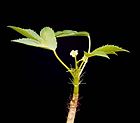Note: This is a project under development. The articles on this wiki are just being initiated and broadly incomplete. You can Help creating new pages.
Jatropha glandulifera - Dravantī
Dravantī is the dried seeds of Jatropha glandulifera Roxb. (Fam. Euphorbiaceae), an evergreen shrub with stout branches and a smooth papery bark, found mostly in the black cotton soil of Deccan but also found in plains of northern India.
Contents
- 1 Uses
- 2 Parts Used
- 3 Chemical Composition
- 4 Common names
- 5 Properties
- 6 Habit
- 7 Identification
- 8 List of Ayurvedic medicine in which the herb is used
- 9 Where to get the saplings
- 10 Mode of Propagation
- 11 How to plant/cultivate
- 12 Commonly seen growing in areas
- 13 Photo Gallery
- 14 References
- 15 External Links
Uses
Skin diseases, Rheumatism, Piles, Snake bites.
Parts Used
Chemical Composition
It contains Jatrophin, jatropholone A, fraxetin, coumarino-lignan.[1]
Common names
| Language | Common name |
|---|---|
| Kannada | Erandane danti, Totla |
| Hindi | Laal Bagharend, Jangali erandi |
| Malayalam | Katalaavanakku |
| Tamil | Kattamanakku, Adalai |
| Telugu | Adavi Amadam, Vatti amudamu |
| Marathi | NA |
| Gujarathi | NA |
| Punjabi | NA |
| Kashmiri | NA |
| Sanskrit | Bṛhaddantī, Vyāghrairāṇḍa, Putraśreṇī |
| English | Purging nut |
Properties
Reference: Dravya - Substance, Rasa - Taste, Guna - Qualities, Veerya - Potency, Vipaka - Post-digesion effect, Karma - Pharmacological activity, Prabhava - Therepeutics.
Dravya
Rasa
Kaṭu
Guna
Laghu, Tīkṣṇa, Snigdha
Veerya
Uṣṇa
Vipaka
Kaṭu
Karma
Pittahara, Kaphahara, Recaka, Viḍbhedana, Dīpana, Viṣaghna
Prabhava
Habit
Identification
Leaf
| Kind | Shape | Feature |
|---|---|---|
| Alternate | Simple | Leaf Margins is Serrate |
Flower
| Type | Size | Color and composition | Stamen | More information |
|---|---|---|---|---|
| Cymes | 2-4cm long | Greenish yellow | Flowering throughout the year |
Fruit
| Type | Size | Mass | Appearance | Seeds | More information |
|---|---|---|---|---|---|
| Capsule | 2-4 cm | Fruiting throughout the year | Many seeds |
Other features
List of Ayurvedic medicine in which the herb is used
- Miśraka Sneha
Where to get the saplings
Mode of Propagation
How to plant/cultivate
The cultivators are expected to adopt it by way of agro- forestry. Considerable land is held by absentee land lords who will be attracted to Jatropha curcas (VanaErand or RatanJyot) as it does not require looking after and gives a net income of Rs 15,000 per hectare.[3]
Commonly seen growing in areas
Trophical area, Trophical area.
Photo Gallery
References
- ↑ The Ayuredic Pharmacopoeia of India Part-1, Volume-5, Page no-50
- ↑ Morphology
- ↑ Cultivation detail
External Links
- Pages that are stubs
- Ayurvedic Herbs known to be helpful to treat Skin diseases
- Ayurvedic Herbs known to be helpful to treat Rheumatism
- Ayurvedic Herbs known to be helpful to treat Piles
- Ayurvedic Herbs known to be helpful to treat Snake bites
- Herbs with Nuts used in medicine
- Herbs with Roots used in medicine
- Herbs with Bark used in medicine
- Herbs with Latex used in medicine
- Herbs with common name in Kannada
- Herbs with common name in Hindi
- Herbs with common name in Malayalam
- Herbs with common name in Tamil
- Herbs with common name in Telugu
- Herbs with common name in Sanskrit
- Herbs with common name in English
- Habit - Shrub
- Index of Plants which can be propagated by Seeds
- Index of Plants which can be propagated by Cuttings
- Herbs that are commonly seen in the region of Trophical area
- Herbs
- Ayurvedic herbs that don't have flower, fruit and leaf photos
- Ayurvedic herbs that don't have seed photos
- Euphorbiaceae
- Pages without herbs images
